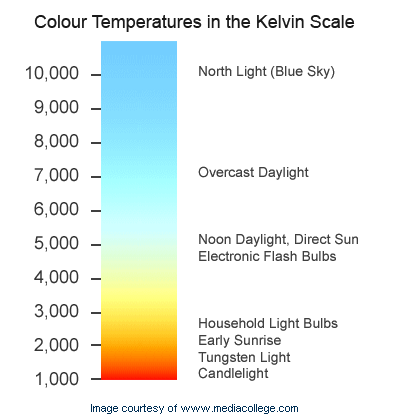Every light source, from the warm, dim glow of a candle to the bright, blue beam of a street light, can be described by two main characteristics. Brightness, measured in lumens, is one of these; the other is colour temperature.
What is Colour Temperature?
Colour temperature is a measurement, in degrees Kelvin (K), of the perceived warmth or coolness of a light source. It should not be confused with the ambient hot and cold temperature of our surroundings, which is measured in degrees Celsius.
In fact, the Kelvin Scale runs in the opposite direction to the temperature scale. Light with a low Kelvin rating, 3,500K or less, is referred to as "warm" light and has a soft yellowy-orange glow. Light with a high Kelvin rating, 6,000K or more, is said to be "cool" and has a blueish white quality.
The colour temperature of different light sources varies considerably. For example, the flame of a candle has a Kelvin rating of 1,850K, moonlight has a Kelvin rating of 4,100K and a fluorescent lamp has a kelvin rating of 5,000K.
Choosing LED Light Bulbs
Unlike incandescent and halogen bulbs, which can only produce one type of light, LEDs are capable of producing a wide spectrum of "white" light. LED Bulbs are typically available in one of two main colour temperatures; warm white (3,000K) and cool white (6,000K).
Warm white is by far the more popular of the two as it bears the closest resemblance to the incandescent and halogen bulbs customers are replacing. It provides a soft, warming effect, making it appropriate for residential use. In particular, it works well with natural tones and, as it is fairly soft, can be used to create a general lighting scheme without seeming too harsh.
Cool White is a much brighter light. More often found in public spaces, such as offices and supermarkets, cool white is increasingly being used in residential lighting for its practical and aesthetic benefits. They can be used to create accent lighting or to provide a powerful task light. They also create a very modern feel within a home and work well with bold, colourful interior décor.
Our Advice
While choosing a colour temperature is largely a matter of personal preference, it is possible to work to a few rules of thumb. Warm white should be used in rooms and areas where you relax and unwind, such as the living room, dining room or bedroom. Cool white should be used where ever you need to concentrate, such as the kitchen, bathroom or a home office. Cool white also generally works better in outdoor locations, as the light is more penetrating.
You may also consider using warm and cool white in combination with one another. This can really enhance the function of a room. For example, in the kitchen, warm white bulbs can be used in the ceiling to create general ambience, while cool white bulbs or LED Strip Lights can be installed along the underside of your kitchen cabinets to create a bright working light above your kitchen worktops.
More Information
For more information about colour temperatures please contact our friendly customer support team on 0116 321 4120 or email cs@wled.co.uk.






